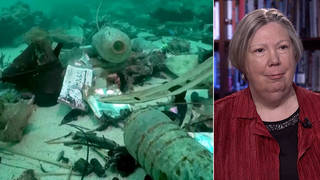
Guests
- Dahr Jamailstaff reporter at Truthout and author of The End of Ice: Bearing Witness and Finding Meaning in the Path of Climate Disruption.
In our extended interview with independent climate journalist Dahr Jamail, he talks about the Democratic National Committee’s decision not to have a debate on the climate crisis, and to bar anyone who participates in an unsanctioned debate from participating in future official Democratic primary debates. Jamail is a staff reporter at Truthout and author of “The End of Ice: Bearing Witness and Finding Meaning in the Path of Climate Disruption.”
Transcript
AMY GOODMAN: This is Democracy Now!, democracynow.org, The War and Peace Report. I’m Amy Goodman, as we continue our conversation with independent climate journalist Dahr Jamail. As Tropical Storm Barry made landfall in Louisiana this weekend, cutting power to well over 100,000 people, as we follow this storm into Arkansas and Alabama and other places, still flash flood alerts for millions of people, an even greater climate catastrophe is slamming Asia, where ongoing heavy rain and flooding have killed well over a hundred people, in Nepal, in India, in Bangladesh, monsoon rains displacing 1 million people.
Dahr Jamail is author of the new book, The End of Ice: Bearing Witness and Finding Meaning in the Path of Climate Disruption. Last year, he won an Izzy Award for his ongoing coverage of human-caused climate change.
If you can talk about the links, Dahr—and I think that’s where our media falls short, well, because they don’t use terms like “climate catastrophe.” They bring you weather reports, “extreme weather,” “severe weather,” they flash across the screen. But when, in the corporate media, have you seen the words “climate catastrophe” or “climate change” or “global warming” flashing as they’re giving us a weather report? What are the links between what happened in Louisiana and the Gulf area with the catastrophe that’s taking place right now in South Asia?
DAHR JAMAIL: Well, you’re so right, Amy, as we simply don’t see the links drawn by the corporate media with what’s happening in front of our faces and the climate crisis that’s driving it. So, if we talk about just using these real-time examples that you just mentioned, with Hurricane Barry, which is causing flooding—it’s caused flooding all across the coast and is now moving inland and dumping more rain on an already-swollen Mississippi River, which is a huge part of the problem of the flooding downstream—well, we’ve known for a long time now—there’s been numerous scientific studies that show that as the atmosphere warms and other impacts from the climate crisis are escalated, then, of course, hurricanes and flooding events are going to escalate, as well. You know, just even recently up in part of Canada, we saw 100- and 500-year floods occurring almost back to back, you know, and that nomenclature used for these types of flooding means, on average, that that intense of a flooding event should only happen once every 100 or 500 or 1,000 years, as the case may be.
So, we’re going to see larger hurricanes. In some places of the world, they’re going to become more frequent. And like this one, much like Hurricane Harvey, that dumped so much rain in Houston just a short number of years ago, they’re slow-moving. They sit there, and they dump enormous amounts of rain, over very, very concentrated amounts of time. And then we see the flooding. We see the Mississippi. We see all these other consequences like all of the fertilizers and pesticides and all of these chemicals used in industrial farming across the Midwest, now those are flushing down the Mississippi, causing dolphin die-offs and increasing amounts of dead zone in the Gulf of Mexico.
So, all of these, we can trace back to amped-up impacts from climate disruption on what it’s causing in hurricanes, how it’s impacting the monsoons over in Asia, as we’ve talked about. And the result is massive environmental degradation, massive loss of human life and, of course, increasing displacement of people in areas where that’s already a major problem.
AMY GOODMAN: And I want to go back to this piece that you did on the number of people who are facing lack of drinking water. A tenth, you say, of the global population could lack drinking water by 2030. We talked about it in Part 1 of this discussion, but elaborate even further what this means, what it is caused by and what we can do about it.
DAHR JAMAIL: Well, that’s roughly 750 million people. It’s half the country of India, which is what that report I cite is addressing, is facing, by 2030, the likelihood of not having enough drinking water. You know, and giving the macro view, as I said earlier, that’s one-tenth the global population. And this is not in isolation. This is already on top of over 100 million people a year—and that’s an extremely conservative figure—but already don’t have enough drinking water on a daily basis. And the growing number of regions around the planet where water scarcity is an issue is also a direct impact of the climate crisis.
So, further talking about India, the city of Chennai, 4 million people—if I remember correctly, it’s the sixth-largest city in the country—is right now in a water crisis, where the government is having to ship in water tankers just so that people have enough water for drinking, and maybe a little bit of washing, if they’re lucky, by 2020. So we’re talking about now not even a year away. Two other major cities in India are also likely to be facing a major water crisis. And this kind of thing is spreading around the globe. And there’s even areas in the U.S., as we’ve seen back in the peak of the drought of California in the Central Valley.
AMY GOODMAN: And this is caused by? Before we go back to the U.S., this is caused by, Dahr?
DAHR JAMAIL: This is caused by the climate crisis, as weather patterns are shifting with what’s happening in the Arctic. You know, one of the famous lines by people studying that part of the crisis is that what happens in the Arctic does not stay in the Arctic. Temperature differentiations are shifting the jet stream. They’re shifting ocean currents. It’s shifting rainfall patterns. And so we have shifted weather patterns, shifted rainfall patterns. We have people, therefore, not enough water to drink. And then that might be punctuated by an extreme flooding event, like what we’re seeing right now, which will be followed by yet another drought.
And then that shows us shifting then back to the U.S. We’re seeing this around the world and in India, but even right here in our front yard, where—in the Midwest, where many farmers couldn’t even plant crops this season because the flooding was so intense that their lands stayed underwater for months on end. We are going to see food price spikes for this. Some of the future food prices for fall are already showing that right here in the U.S. And we have to remember that the Arab Spring was largely caused by the climate crisis, as well. When people don’t have enough food to eat, for example, if a family is there watching their children go hungry and, in some instances, starve to death, in Syria, then that’s going to be a problem. These people are going to go to any lengths to force the government to do something. And if people here in this country think that that can’t happen here, well, what’s happened in the U.S. is—in the Midwest is really setting the stage for that.
So, we are seeing these dramatic natural events as evidence, but then how this affects humans. We’re seeing it abroad. And I think we’re going to see it—in addition to the immigration crisis that you just did the show on, we’re going to see it much more intensely here not with just immigrants, but with people who have been in this country for generations.
AMY GOODMAN: Dahr, you pointed out in one of your pieces that in some areas of China, fruit trees have to be pollinated by hand because there’s such a dearth of pollinators. Can you explain what this is all about?
DAHR JAMAIL: Right, and I should add a caveat to that, just a recent update, where the Trump administration made news by passing legislation to allow through a pesticide use that is known to kill bees. So, that underscores the severity of the crisis of the insect population.
I think when I was on your show earlier this year, not long after the book was released, talking about the insect crisis, that several studies had just come out showing that at our current trajectory we’re losing 2.4% of insect biomass annually. So, at that trajectory, assuming it does not accelerate—which is a false assumption, but let’s just assume it—that still means that by 2100—I’m sorry, within a hundred years, no more insects on a functional basis on the planet. And we’re already seeing this play out.
So that brings us current to what you just mentioned happening in China, where people are literally having to go around and use humans to pollinate crops, because insects are failing to do the job. So, you know that we’re in trouble when enough of the ecosystem has already failed in some parts of the planet, where humans are having to go out and pollinate the crops. And again, we see evidence of that here in places like California, where, on an annual basis, bees are having to be brought in to certain crops to do the job. This is not sustainable. It requires fossil fuels. It requires human power. And ultimately, over the long term, there’s not going to be enough of that to get the job done. Nothing can replace these natural ecosystems as they fail.
AMY GOODMAN: Dahr Jamail, you were awarded the Martha Gellhorn Prize for Investigative Journalism in 2008 for your reporting on the Iraq War. Last year, you won the Izzy Award for your ongoing coverage of human-caused climate change. Talk about the connections between war, the military—in this country, the U.S. Pentagon—and climate change, climate catastrophe.
DAHR JAMAIL: Well, there are several, in no particular order. It’s interesting to note that I can remember as far back as 2006 writing about the Pentagon’s Quadrennial Defense Review report, which is the report they release on an annual basis showing what they see are the biggest security threats. And even back then, 13 years ago, they were listing the climate crisis as one of the biggest security threats the country faces. That has been in that report every subsequent year. And to date, the U.S. military continues to say that.
That said, on the negative tally sheet for the military, they are, as an entity, the single largest emitter of CO2 emissions on the planet. That’s a real problem. They are already war-gaming for certain scenarios and drawing up plans to how to respond to impacts of the climate crisis, like the refugee crisis and the immigrant crisis that we see, not just here, not just on the borders here, people being forced from their homes in Central America, not having enough food and water, and insecurity that they have to literally leave their homes. And the military is preparing for that, but around the world. So, in other places where they’re gearing up for, what if there has to be a water war? What if we need more land because the arable land in this country is not enough? These are the types of things that the U.S. military is preparing for right now.
And then the other layer of that conversation that I would add, that I briefly touched upon earlier during our live discussion, is the Arab Spring. So, if we look across that country, let’s remember that it was the vegetable vendor in Tunisia who carried out self-immolation. This was really the catalyzing event that kicked that whole revolution off across the broader region, and it was because of food prices. It was because farmers lacked enough water. Crops were failing. There was ongoing drought across several of those countries—that one and, in particular, Syria—that forced people into the cities looking for other work. Governments weren’t able to step up to the plate, or weren’t willing to help them out. We had a completely politically destabilized situation. And several of those countries are now failed states, Syria being one of them, barely hanging on by a thread as we speak, as Assad maintains power. And it’s essentially a permanent war zone. So, this is what happens when people don’t eat, when crops fail, when the climate patterns shift and the rainfall patterns shift. And the U.S. military is acutely aware of this. They’ve been studying it for a long time, and they’re actively preparing for it.
AMY GOODMAN: I wanted to ask you about the presidential primary debates that are taking place. The next one will take place next week or the week after. The Democratic National Committee has threatened Jay Inslee, right? He’s the—well, you’re in Seattle right now. He’s the governor of Seattle. He’s also running for president. He called for a debate solely on the climate crisis. There were, what, four hours of debate in the first presidential primary, because there are so many presidential candidates on the Democratic side. I think there was less than seven minutes were devoted to dealing with the climate crisis. So he said, why not just have a whole debate on this issue? The response of the Democratic National Committee, Tom Perez and the DNC, was there will not be a debate solely based on the climate crisis, and if you participate in an unsanctioned debate, you will be barred from participating in future official Democratic primary debates. Dahr Jamail, your response?
DAHR JAMAIL: Well, first, shaking my head. But then, again, the writing’s on the wall. There it is. Who is the DNC loyal to? Whose marching orders are they following, where they—that is their response, despite the fact that all polls show that the single most important issue across Democratic voters’ minds is the climate crisis? And you have Washington state Governor Jay Inslee trying to bring that as a fore, making it his sole issue. He’s a one-issue candidate. And yet, he is being pushed out. And the fact that in these debates they’ve spent a grand total of seven minutes, which is seven minutes more than they have in the past years, as pathetic as that is, but at seven years—or, I’m sorry, seven minutes on the single most important issue on the vast majority of Democratic voters’ minds. And so, again, you know, just like the current regime in control of this country, which is clearly behaving in a very authoritarian way, we have the DNC, supposedly the Democratic Party that’s the better alternative to that, that is hardly behaving much better.
AMY GOODMAN: Finally, as we wrap up this two-part interview, this monthly report you refer to, that you put out, the monthly report on climate news, you divide your piece up into—well, under the elements earth, water, fire, air. What have you found tracking the events along these lines and the intensification of the climate crisis?
DAHR JAMAIL: Yes, I’ve been writing these dispatches every month for about five years now. And it’s really incredible to me to see—I don’t even need to look back over the last five years, but just since my book was released—the title, The End of Ice, I didn’t know how right I had that, because just since that book is released, we’ve seen reports come out and show a sixfold increase in Antarctica, the ice continent, just since the 1970s. Things are so intense in Greenland now with the acceleration of melting, that for the first time that I’ve seen, even some conservative scientists are talking about the possibility of losing the entire ice sheet of Greenland, which alone would bring 24 feet of sea level rise across the globe.
So, all trends are accelerating, and not just accelerating in a linear fashion—and this is, I think, a very important note to end on—but they’re accelerating and moving into nonlinear territory. And several of the scientists that I’ve interviewed for stories and for my book said this is the single most important factor that worries them the most and keeps them up at night, is the nonlinear, very unpredictable fashion of once we have enough of these different feedback loops kicked in, which I believe we do already, then we’re going to be seeing nonlinear, abrupt, catastrophic changes in the future as a result of the climate crisis.
AMY GOODMAN: And nonlinear means? We have 30 seconds.
DAHR JAMAIL: It means they are unpredictable. They do not move from point A to point B. It’s more of a straight-up, abrupt, exponential, explosive fashion.
AMY GOODMAN: Dahr Jamail, we want to thank you for being with us, independent journalist, author of The End of Ice: Bearing Witness and Finding Meaning in the Path of Climate Disruption. We’ll link to your latest piece, “Over One-Tenth of Global Population Could Lack Drinking Water by 2030,” speaking to us from Seattle, Washington.
To see Part 1 of our discussion, go to democracynow.org. I’m Amy Goodman. Thanks so much for joining us.










Media Options